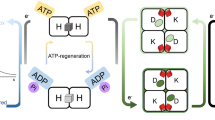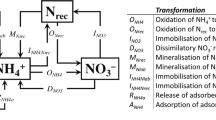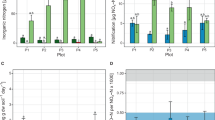Abstract
Nitrogen fixation, the reaction that transforms atmospheric nitrogen into bioavailable ammonia and is responsible for the supply of nitrogen to Earth’s ecosystems, is mediated by the enzyme nitrogenase. This reaction requires molybdenum (Mo) or vanadium (V) in addition to iron (Fe) (refs 1, 2). Therefore, the availability of these trace metals may control the Earth’s nitrogen cycle3,4. Many bacteria release strong iron-binding compounds (siderophores) for iron acquisition5,6, but the effect of these compounds on Mo and V availability to nitrogen-fixing organisms is not well understood. Here, we show that the siderophores produced in cultures of Azotobacter vinelandii while fixing atmospheric nitrogen under limitation by Mo or V form strong complexes with molybdate and vanadate, and that these complexes are available for uptake. We also show that addition of these siderophores rapidly reverses the effect of other natural binding compounds that make Mo and V unavailable for uptake. Our results resolve the long-standing debate regarding the existence of bacterial ‘molybdophores’7,8,9, as well as the corollary question regarding ‘vanadophores’. We conclude that the production of strong binding compounds may be a widespread strategy for metal acquisition by bacteria, implying that the availability of Mo and V may be critical for the nitrogen cycle of terrestrial ecosystems.
This is a preview of subscription content, access via your institution
Access options
Subscribe to this journal
Receive 12 print issues and online access
$259.00 per year
only $21.58 per issue
Buy this article
- Purchase on Springer Link
- Instant access to full article PDF
Prices may be subject to local taxes which are calculated during checkout




Similar content being viewed by others
References
Eady, R. E. Structure-function relationships of the alternative nitrogenases. Chem. Rev. 96, 3013–3030 (1996).
Joerger, R. D. & Bishop, P. E. Bacterial alternative nitrogen fixation systems. Crit. Rev. Microbiol. 16, 1–14 (1988).
Kustka, A., Sanuda-Wilhelmy, S., Carpenter, E. J., Capone, D. & Raven, J. A. A revised estimate of the iron use efficiency of nitrogen fixation, with special reference to the marine N2 fixing cyanobacterium, Trichodesmium spp. (Cyanophyta). J. Phycol. 39, 12–25 (2003).
Hungate, B. A. et al. CO2 elicits long-term decline in nitrogen fixation. Science 304, 1291 (2004).
Butler, A. Acquisition and utilization of transition metal ions by marine organisms. Science 281, 207–210 (1998).
Stintzi, A., Barnes, C., Xu, J. & Raymond, K. N. Microbial iron transport via siderophore shuttle: A membrane ion transport paradigm. Proc. Natl Am. Soc. 97, 10691–10696 (2000).
Liermann, L. J., Guynn, R. L., Anbar, A. & Brantley, S. L. Production of a molybdophore during metal-targeted dissolution of silicates by soil bacteria. Chem. Geol. 220, 285–302 (2005).
Cornish, A. S. & Page, W. J. Role of molybdate and other transition metals in the accumulation of protochelin by Azotobacter vinelandii. Appl. Environ. Microbiol. 66, 1580–1586 (2000).
Page, W. J. & von Tigerstrom, M. Iron- and molybdenum-repressible outer membrane proteins in competent Azotobacter vinelandii. J. Bacteriol. 151, 237–242 (1982).
Sunda, W. G., Price, N. M. & Morel, F. M. M. in Algal Culturing Techniques (ed. Anderson, R.) 35–64 (Elsevier, Burlington, 2005).
Rose, A. L. & Waite, T. D. Kinetics of hydrolysis and precipitation of ferric iron in seawater. Environ. Sci. Technol. 37, 3897–3903 (2003).
Joerger, R. D., Jacobson, M. R., Premakumar, R., Wolfinger, E. D. & Bishop, P. E. Nucleotide sequence and mutational analysis of the structural genes (anfHDGK) for the second alternative nitrogenase from Azotobacter vinelandii. J. Bacteriol. 171, 1075–1086 (1989).
Neilands, J. B. Microbial iron compounds. Ann. Rev. Biochem. 50, 715–731 (1981).
Bellenger, J.-P. et al. Complexation of oxoanions and cationic metals by the biscatecholate siderophore azotochelin. J. Biol. Inorg. Chem. 12, 367–376 (2007).
Duhme, A.-K., Hider, R. C., Naldrett, M. J. & Pau, R. N. The stability of the molybdenum-azotochelin complex and its effect on siderophore production in Azotobacter vinelandii. J. Biol. Inorg. Chem. 3, 520–526 (1998).
Khodr, H. H., Hider, R. C. & Duhme, A.-K. The iron-binding properties of aminochelin, the mono(catecholamine) siderophore of Azotobacter vinelandii. J. Biol. Inorg. Chem. 7, 891–896 (2002).
Cornish, A. S. & Page, W. J. The catecholate siderophores of Azotobacter vinelandii: Their affinity for iron and role in oxygen stress management. Microbiology 144, 1747–1754 (1998).
Kraemer, S. M. Iron oxide dissolution and solubility in the presence of siderophores. Aquat. Sci. 66, 3–18 (2004).
Pau, R. N. & Lawson, D. M. in Metal Ions in Biological Systems: Molybdenum and Tungsten: Their Roles in Biological Processes (eds Sigel, A. & Sigel, H.) 31–74 (Dekker, Basel, 2002).
Siemann, S., Schneider, K., Oley, M. & Muller, A. Characterization of a tungsten-substituted nitrogenase isolated from Rhodobacter capsulatus. Biochemistry 42, 3846–3857 (2003).
Kiss, T. & Farkas, E. Metal-binding ability of Desferrioxamine B. J. Incl. Phenom. Mol. Recognit. Chem. 32, 385–403 (1998).
Pratte, B. S. & Thiel, T. High-affinity vanadate transport system in the cyanobacterium Anabaena variabilis ATCC 29413. J. Bacteriol. 188, 464–468 (2006).
Kim, H. J. et al. Methanobactin, a copper-acquisition compound from methane-oxidizing bacteria. Science 305, 1612–1615 (2004).
Sparks, D. L. in Metal and Oxyanion Sorption on Naturally Occurring Oxide and Clay Mineral Surfaces (ed. Grassian, V.) (Taylor and Francis, Boca Raton, 2005).
Crews, T. E., Farrington, H. & Vitousek, P. M. Changes in asymbiotic, heterotrophic nitrogen fixation on leaf litter of Metrosideros polymorpha with long-term ecosystem development in Hawaii. Ecosystems 3, 386–395 (2000).
Alberic, P. Interactions between trace elements and dissolved organic matter in the stagnant anoxic deep layer of a meromictic lake. Limnol. Oceanogr. 45, 1088–1096 (2000).
Essen, S. A., Bylund, D., Holmstrom, S. J. M., Moberg, M. & Lundstrom, U. S. Quantification of hydroxamate siderophores in soil solutions of podzolic soil profiles in Sweden. Biometals 19, 269–282 (2006).
Silvester, W. B. Molybdenum limitation of asymbiotic nitrogen fixation in forests of pacific Northwest America. Soil Biol. Biochem. 21, 283–289 (1989).
Gupta, U. (ed.) Molybdenum in Agriculture (Cambridge Univ. Press, Cambridge, 1997).
Acknowledgements
The authors wish to thank S. Brantley, T. M. Loveless and P. E. Bishop for providing the wild-type strain OP and the mutant strains CA11.70 and F196. We are also grateful to François M. M. Morel for useful discussions and his support throughout this work. We thank D. Little and E. Chan for their help with mass spectrometry. This work was supported by grants from the NSF (CHE-0221978, Center for Environmental Bioinorganic Chemistry and DEB-0614116), as well as fellowships from the French Department of Education to J.P.B and from the Camille and Henry Dreyfus Postdoctoral Program in Environmental Chemistry to T.W.
Author information
Authors and Affiliations
Corresponding author
Supplementary information
Supplementary Information
Supplementary figures S1-S3 (PDF 256 kb)
Rights and permissions
About this article
Cite this article
Bellenger, J., Wichard, T., Kustka, A. et al. Uptake of molybdenum and vanadium by a nitrogen-fixing soil bacterium using siderophores. Nature Geosci 1, 243–246 (2008). https://doi.org/10.1038/ngeo161
Received:
Accepted:
Published:
Issue Date:
DOI: https://doi.org/10.1038/ngeo161
This article is cited by
-
Salicylate coordination in metal-protochelin complexes
BioMetals (2022)
-
Molybdenum Role in Nitrogen Bioavailability of Wheat-Soil System Using the Natural 15N Abundance Technique
Journal of Soil Science and Plant Nutrition (2022)
-
The Mode of Integration Between Azotobacter and Rhizobium Affect Plant Growth, Yield, and Physiological Responses of Pea (Pisum sativum L.)
Journal of Soil Science and Plant Nutrition (2022)
-
The occurrence of vanadium in nature: its biogeochemical cycling and relationship with organic matter—a case study of the Early Cambrian black rocks of the Niutitang Formation, western Hunan, China
Acta Geochimica (2021)
-
Insights into the chemistry of the amphibactin–metal (M3+) interaction and its role in antibiotic resistance
Scientific Reports (2020)



